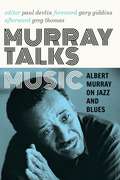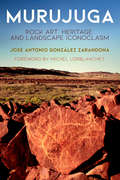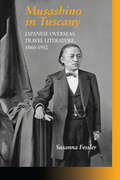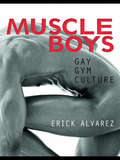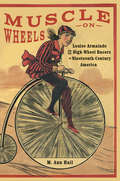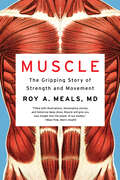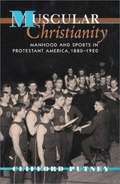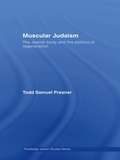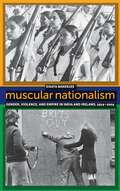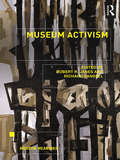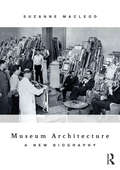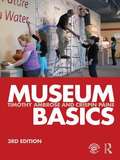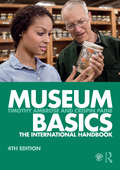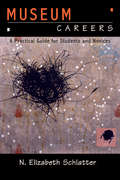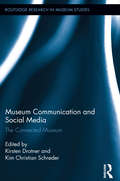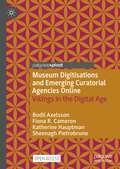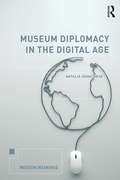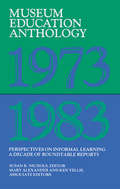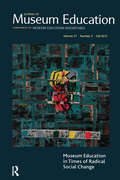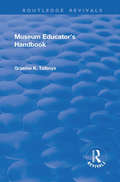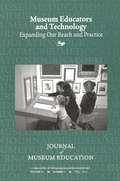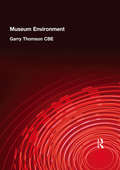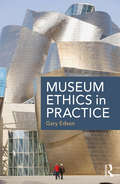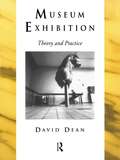- Table View
- List View
Murray Talks Music: Albert Murray on Jazz and Blues
by Albert MurrayThe year 2016 will mark the centennial of the birth of Albert Murray (1916–2013), who in thirteen books was by turns a lyrical novelist, a keen and iconoclastic social critic, and a formidable interpreter of jazz and blues. Not only did his prizewinning study Stomping the Blues (1976) influence musicians far and wide, it was also a foundational text for Jazz at Lincoln Center, which he cofounded with Wynton Marsalis and others in 1987. Murray Talks Music brings together, for the first time, many of Murray&’s finest interviews and essays on music—most never before published—as well as rare liner notes and prefaces.For those new to Murray, this book will be a perfect introduction, and those familiar with his work—even scholars—will be surprised, dazzled, and delighted. Highlights include Dizzy Gillespie&’s richly substantive 1985 conversation; an in-depth 1994 dialogue on jazz and culture between Murray and Wynton Marsalis; and a long 1989 discussion on Duke Ellington between Murray, Stanley Crouch, and Loren Schoenberg. Also interviewed by Murray are producer and impresario John Hammond and singer and bandleader Billy Eckstine. All of thse conversations were previously lost to history. A celebrated educator and raconteur, Murray engages with a variety of scholars and journalists while making insightful connections among music, literature, and other art forms—all with ample humor and from unforeseen angles.Leading Murray scholar Paul Devlin contextualizes the essays and interviews in an extensive introduction, which doubles as a major commentary on Murray&’s life and work. The volume also presents sixteen never-before-seen photographs of jazz greats taken by Murray.No jazz collection will be complete without Murray Talks Music, which includes a foreword by Gary Giddins and an afterword by Greg Thomas.
Murujuga: Rock Art, Heritage, and Landscape Iconoclasm
by José Antonio González ZarandonaA fascinating case study of the archaeological site at Murujuga, AustraliaLocated in the Dampier Archipelago of Western Australia, Murujuga is the single largest archaeological site in the world. It contains an estimated one million petroglyphs, or rock art motifs, produced by the Indigenous Australians who have historically inhabited the archipelago. To date, there has been no comprehensive survey of the site's petroglyphs or those who created them. Since the 1960s, regional mining interests have caused significant damage to this site, destroying an estimated 5 to 25 percent of the petroglyphs in Murujuga. Today, Murujuga holds the unenviable status of being one of the most endangered archaeological sites in the world.José Antonio González Zarandona provides a full postcolonial analysis of Murujuga as well as a geographic and archaeological overview of the site, its ethnohistory, and its considerable significance to Indigenous groups, before examining the colonial mistreatment of Murujuga from the seventeenth century to the present. Drawing on a range of postcolonial perspectives, Zarandona reads the assaults on the rock art of Murujuga as instances of what he terms "landscape iconoclasm": the destruction of art and landscapes central to group identity in pursuit of ideological, political, and economic dominance. Viewed through the lens of landscape iconoclasm, the destruction of Murujuga can be understood as not only the result of economic pressures but also as a means of reinforcing—through neglect, abandonment, fragmentation, and even certain practices of heritage preservation—the colonial legacy in Western Australia. Murujuga provides a case study through which to examine, and begin to reject, archaeology's global entanglement with colonial intervention and the politics of heritage preservation.
Musashino in Tuscany: Japanese Overseas Travel Literature, 1860–1912 (Michigan Monograph Series in Japanese Studies #50)
by Susanna FesslerBy the late Meiji period Japanese were venturing abroad in great numbers, and some of those who traveled kept diaries and wrote formal travelogues. These travelogues reflected a changing view of the West and changing artistic sensibilities in the long-standing Japanese literary tradition of travel writing (kikoobungaku). This book shows that overseas Meiji-period travel writers struck out to create a dynamic new type of travel literature, one that had a solid foundation in traditional Japanese kikobungaku yet also displayed influence from the West. Musashino in Tuscany specifically examines the poetic imagery and allusion in these travelogues and reveals that when Japanese traveled to the West in the mid-nineteenth century, the images they wrote about tended to be associated not with places initially discovered by the Japanese traveler but with places that already existed in Western fame and lore. And unlike imagery from Japanese traveling in Japan, which was predominantly nature based, Japanese overseas travel imagery was often associated with the manmade world.
Muscle Boys: Gay Gym Culture
by Erick AlvarezWhat was once a lifestyle for a small number of gay men in big cities has become a way of life for many, and the gay gym is now a culture on its own. Muscle Boys: Gay Gym Culture explores the evolution and current structure of this gay subculture that surfaced in San Francisco, West Hollywood, and New York during the 1970s. Covering ancient Greek gymnasium culture, modern bodybuilding practices, and homoerotic muscle-bound media, Muscles Boys examines the origins of the male athletic ideal. A sociological investigation on masculinity, fitness, HIV, steroids, and sex in the locker room, Muscle Boys dissects the gay gym experience, and celebrates gay body culture and its role in modern gay life. Author Erick Alvarez offers a candid study of the gay gym from his perspective as a physical trainer in the San Francisco Bay area, and from his interviews and online surveys of nearly 6,000 gay men. Muscle Boys: Gay Gym Culture is an enlightening read for anyone interested in gay body culture, and a valuable resource for academics working in GLBT studies, human sexuality, psychology, or athletics.
Muscle on Wheels: Louise Armaindo and the High-Wheel Racers of Nineteenth-Century America
by M. Ann HallThe majestic high-wheel bicycle, with its spider wheels and rubber tires, emerged in the mid-1870s as the standard bicycle. A common misconception is that, bound by Victorian dress and decorum, women were unable to ride it, only taking up cycling in the 1880s with the advent of the chain-driven safety bicycle. On the contrary, women had been riding and even racing some form of the bicycle since the first vélocipèdes appeared in Europe early in the nineteenth century. <p><p> Challenging the understanding that bicycling was a purely masculine sport, Muscle on Wheels tells the story of women's high-wheel racing in North America in the 1880s and early 1890s, with a focus on a particular cyclist: Louise Armaindo (1857–1900). Among Canada's first women professional athletes and the first woman who was truly successful as a high-wheel racer, Armaindo began her career as a strongwoman and trapeze artist in Chicago in the 1870s before discovering high-wheel bicycle racing. Initially she competed against men, but as more women took up the sport, she raced them too. Although Armaindo is the star of Muscle on Wheels, the book is also about other women cyclists and the many men – racers, managers, trainers, agents, bookmakers, sport administrators, and editors of influential cycling magazines – who controlled the sport, especially in the United States. <p> The story of working-class Victorian women who earned a living through their athletic talent, Muscle on Wheels showcases an exciting moment in women's and athletic history that is often forgotten or misconstrued.
Muscle: The Gripping Story Of Strength And Movement
by Roy A. Meals MD“Filled with illustrations, illuminating stories, and historical deep dives, Muscle will give you new insight into the power of our bodies.” —Milan Polk, Men’s Health An entertaining illustrated deep dive into muscle, from the discovery of human anatomy to the latest science of strength training. Muscle tissue powers every heartbeat, blink, jog, jump, and goosebump. It is the force behind the most critical bodily functions, including digestion and childbirth, as well as extreme feats of athleticism. We can mold our muscles with exercise and observe the results. In this lively, lucid book, orthopedic surgeon Roy A. Meals takes us on a wide-ranging journey through anatomy, biology, history, and health to unlock the mysteries of our muscles. He breaks down the three different types of muscle—smooth, skeletal, and cardiac—and explores major advancements in medicine and fitness, including cutting-edge gene-editing research and the science behind popular muscle conditioning strategies. Along the way, he offers insight into the changing aesthetic and cultural conception of muscle, from Michelangelo’s David to present-day bodybuilders, and shares fascinating examples of strange muscular maladies and their treatment. Brimming with fun facts and infectious enthusiasm, Muscle sheds light on the astonishing, essential tissue that moves us through life.
Muscular Christianity: Manhood and Sports in Protestant America, 1880-1920
by Clifford PutneyDissatisfied with a Victorian culture focused on domesticity and threatened by physical decline in sedentary office jobs, American men in the late nineteenth century sought masculine company in fraternal lodges and engaged in exercise to invigorate their bodies. One form of this new manly culture, developed out of the Protestant churches, was known as muscular Christianity. In this fascinating study, Clifford Putney details how Protestant leaders promoted competitive sports and physical education to create an ideal of Christian manliness.
Muscular Judaism: The Jewish Body and the Politics of Regeneration (Routledge Jewish Studies Series)
by Todd Samuel PresnerProviding valuable insights into an element of European nationalism and modernist culture, this book explores the development of the 'Zionist body' as opposed to the traditional stereotype of the physically weak, intellectual Jew. It charts the cultural and intellectual history showing how the 'Muscle Jew' developed as a political symbol of national regeneration.
Muscular Nationalism: Gender, Violence, and Empire in India and Ireland, 1914-2004 (Routledge Contemporary South Asia Ser.)
by Sikata BanerjeeA particular dark triumph of modern nationalism has been itsability to persuade citizens to sacrifice their lives for a political visionforged by emotional ties to a common identity. Both men and women can respond to nationalistic calls to fight thatportray muscular warriors defending their nation against an easily recognizableenemy. This “us versus them” mentality can be seen in sectarian violencebetween Hindus and Muslims, Tamils and Sinhalas, Serbs and Kosovars, andProtestants and Catholics. In MuscularNationalism, Sikata Banerjee takes a comparative look at Indiaand Ireland andthe relationship among gender, violence, and nationalism. Exploring key textsand events from 1914-2004, Banerjee explores how women negotiate “muscularnationalisms” as they seek to be recognized as legitimate nationalists andequal stakeholders in their national struggles. Banerjee argues that the gendered manner in which dominantnationalism has been imagined in most states in the world has had importantimplications for women’s lived experiences. Drawing on a specific intersection of gender and nationalism, shediscusses the manner in which women negotiate a political and social terraininfused with a masculinized dream of nation-building. India and Ireland—two states shaped by thelegacy of British imperialism and forced to deal with modern political/socialconflict centering on competing nationalisms—provide two provocative casestudies that illuminate the complex interaction between gender and nation.
Museum Activism (Museum Meanings)
by Richard Sandell Robert R. JanesOnly a decade ago, the notion that museums, galleries and heritage organisations might engage in activist practice, with explicit intent to act upon inequalities, injustices and environmental crises, was met with scepticism and often derision. Seeking to purposefully bring about social change was viewed by many within and beyond the museum community as inappropriately political and antithetical to fundamental professional values. Today, although the idea remains controversial, the way we think about the roles and responsibilities of museums as knowledge based, social institutions is changing. Museum Activism examines the increasing significance of this activist trend in thinking and practice. At this crucial time in the evolution of museum thinking and practice, this ground-breaking volume brings together more than fifty contributors working across six continents to explore, analyse and critically reflect upon the museum’s relationship to activism. Including contributions from practitioners, artists, activists and researchers, this wide-ranging examination of new and divergent expressions of the inherent power of museums as forces for good, and as activists in civil society, aims to encourage further experimentation and enrich the debate in this nascent and uncertain field of museum practice. Museum Activism elucidates the largely untapped potential for museums as key intellectual and civic resources to address inequalities, injustice and environmental challenges. This makes the book essential reading for scholars and students of museum and heritage studies, gallery studies, arts and heritage management, and politics. It will be a source of inspiration to museum practitioners and museum leaders around the globe.
Museum Architecture: A New Biography (Museum Meanings Ser.)
by Suzanne MacLeodRecent decades have witnessed an explosion of museum building around the world and the subsequent publication of multiple texts dedicated to the subject. Museum Architecture: A new biography focuses on the stories we tell of museum buildings in order to explore the nature of museum architecture and the problems of architectural history when applied to the museum and gallery. Starting from a discussion of the key issues in contemporary museum design, the book explores the role of architectural history in the prioritisation of specific stories of museum building and museum architects and the exclusion of other actors from the history of museum making. These omissions have contemporary relevance and impact directly on the ways in which the physical structures of museums are shaped. Theoretically, the book places a particular emphasis on the work of Pierre Bourdieu and Henri Lefebvre in order to establish an understanding of buildings as social relations; the outcome of complex human interactions and relationships. The book utilises a micro history, an in-depth case study of the ‘National Gallery of the North’, the Walker Art Gallery in Liverpool, to expose the myriad ways in which museum architecture is made. Coupled with this detailed exploration is an emphasis on contemporary museum design which utilises the understanding of the social realities of museum making to explore ideas for a socially sustainable museum architecture fit for the twenty-first century.
Museum Basics
by Timothy Ambrose Crispin PaineMuseums throughout the world have common needs and face common challenges. Keeping up-to-date with new ideas and changing practice is challenging for small and medium-sized museums where time for reading and training is often restricted. This new edition of Museum Basics has therefore been produced for the many museums worldwide that operate with limited resources and few professional staff. The comprehensive training course provided within the book is also suitable for museum studies students who wish to gain a full understanding of work within a museum. Drawing from a wide range of practical experience, the authors provide a basic guide to all aspects of museum work, from audience development and education, through collections management and conservation, to museum organisation and forward planning. Organised on a modular basis with over 110 Units, Museum Basics can be used as a reference work to assist day-to-day museum management and as the key textbook in pre-service and in-service training programmes. It is designed to be supplemented by case studies, project work and group discussion. This third edition has been fully updated and extended to take account of the many changes that have occurred in the world of museums in the last five years. It includes over 100 new diagrams supporting the text, a glossary, sources of information and support as well as a select bibliography. Museum Basics is also now supported by its own companion website providing a wide range of additional resources for the reader.
Museum Basics: The International Handbook (Heritage: Care-Preservation-Management)
by Timothy Ambrose Crispin PaineThis fourth edition of Museum Basics has been produced for use in the many museums worldwide that operate with few professional staff and limited resources. The fourth edition has been fully updated to reflect the many changes that have taken place in museums around the world over the last six years. Drawing from a wide range of practical experience, the authors provide a basic guide to all aspects of museum work, from audience development and learning, through collections management and conservation, to museum management and forward planning. Museum Basics is organised on a modular basis, with over 100 units in eight sections. It can be used both as a reference work to assist day-to-day museum management, and as the key textbook for pre-service and in-service museum training programmes, where it can be supplemented by case studies, project work and group discussion. This edition includes over 100 diagrams to support the text, as well as a glossary, sources of information and support and a select bibliography. Museum Basics is also supported by its own companion website, which provides a wide range of additional resources for readers. Museum Basics aims to help the museum practitioner keep up to date with new thinking about the function of museums and their relationships with the communities they serve. The training materials provided within the book are also suitable for pre-service and in-service students who wish to gain a full understanding of work in a museum.
Museum Careers: A Practical Guide for Students and Novices
by N Elizabeth SchlatterThis concise volume is the place to start for anyone considering a career in museums. Museum professional and author N. Elizabeth Schlatter outlines the nature of the profession as a whole, the rewards and challenges of museum work, types of museums, and jobs within museums, including salary ranges. She discusses options for education and training, and offers suggestions on how to secure a job and move up the career ladder. Interviews with museum professionals from a variety of disciplines and backgrounds demonstrate different career paths and offer unique and helpful advice. For novices in the field, students in museum studies programs, or anyone considering museums as a career choice, Schlatter’s book is an essential starting point.
Museum Communication and Social Media: The Connected Museum (Routledge Research in Museum Studies #6)
by Kirsten Drotner Kim Christian SchrøderVisitor engagement and learning, outreach, and inclusion are concepts that have long dominated professional museum discourses. The recent rapid uptake of various forms of social media in many parts of the world, however, calls for a reformulation of familiar opportunities and obstacles in museum debates and practices. Young people, as both early adopters of digital forms of communication and latecomers to museums, increasingly figure as a key target group for many museums. This volume presents and discusses the most advanced research on the multiple ways in which social media operates to transform museum communications in countries as diverse as Australia, Denmark, Germany, Norway, the UK, and the United States. It examines the socio-cultural contexts, organizational and education consequences, and methodological implications of these transformations.
Museum Design with, by, and for Children: Innovative International Approaches (Global Perspectives on Children in Museums)
by Clare MurrayMuseum Design with, by, and for Children makes an important contribution to contemporary museum theory and practice by focusing on the role and rights of children in museums from a new angle: design.At a time when museum practitioners are challenged to work within their particular buildings and contexts to help the children in their communities feel welcome, invited, and involved, this book presents alternative approaches that are being implemented across the world and pushing the museum field further in its commitment to children, starting with design. This book provides inspirational insights into large- and small-scale ways that children can participate in museum design and therefore exercise their human rights, gain agency, develop their sense of belonging, and form part of museum communities. Drawing on case studies from Argentina, Australia, England, Italy, Mexico, and Paraguay, and theoretical insights from the Reggio Emilia Approach, constructivism, designerly learning, laboratory-style design, and the work of Paulo Freire and Francesco Tonucci, this book explores the extent to which museums’ design processes are child-centered and how children’s material culture can be reflected in the museum design work that will ultimately shape their own early learning experiences. This book explores museum design as a process that involves key stakeholders in procedural planning and associated tasks and discussions, such as those regarding color, light, shape, form, space, and building materials.Museum Design with, by, and for Children will be valuable for museum practitioners, students, and researchers with an interest in children’s experiences in museums, particularly how children can be empowered as active participants with rights to the museum.
Museum Digitisations and Emerging Curatorial Agencies Online: Vikings in the Digital Age
by Fiona R. Cameron Bodil Axelsson Katherine Hauptman Sheenagh PietrobrunoThis open access book explores the multiple forms of curatorial agencies that develop when museum collection digitisations, narratives and new research findings circulate online. Focusing on Viking Age objects, it tracks the effects of antagonistic debates on discussion forums and the consequences of search engines, personalisation, and machine learning on American-based online platforms. Furthermore, it considers eco-systemic processes comprising computation, rare-earth minerals, electrical currents and data centres and cables as novel forms of curatorial actions. Thus, it explores curatorial agency as social constructivist, semiotic, algorithmic, and material. This book is of interest to scholars and students in the fields of museum studies, cultural heritage and media studies. It also appeals to museum practitioners concerned with curatorial innovation at the intersection of humanist interpretations and new materialist and more-than-human frameworks.
Museum Diplomacy in the Digital Age (Museum Meanings)
by Natalia GrinchevaMuseum Diplomacy in the Digital Age explores online museums as sites of contemporary cultural diplomacy. Building on scholarship that highlights how museums can constitute and regulate citizens, construct national communities, and project messages across borders, the book explores the political powers of museums in their online spaces. Demonstrating that digital media allow museums to reach far beyond their physical locations, Grincheva investigates whether online audiences are given the tools to co-curate museums and their collections to establish new pathways for international cultural relations, exchange and, potentially, diplomacy. Evaluating the online capacities of museums to exert cultural impacts, the book illuminates how online museum narratives shape audience perceptions and redefine their cultural attitudes and identities. Museum Diplomacy in the Digital Age will be of interest to academics and students teaching or taking courses on museums and heritage, communication and media, cultural studies, cultural diplomacy, international relations and digital humanities. It will also be useful to practitioners around the world who want to learn more about the effect digital museum experiences have on international audiences.
Museum Education Anthology, 1973-1983: Perspectives on Informal Learning
by Susan K. NicholsClassic set of 45 articles from the first decade of the Journal of Museum Education and its predecessor, Roundtable Reports. Articles and essays focus on teaching strategies, introspective glances at the museum education field, reports of program successes and near successes, evaluative studies, and reviews of exhibitions and literature related to object-based learning. This title is sponsored by The Museum Education Roundtable. The Museum Education Roundtable (MER) is a non-profit organization based in Washington, DC, dedicated to enriching and promoting the field of Museum Education.
Museum Education in Times of Radical Social Change: Journal of Museum Education 37:3 Thematic Issue
by Asja Mandic Patrick RobertsSponsored by the Museum Education Roundtable
Museum Educator's Handbook (Routledge Revivals)
by Graeme K TalboysThis title was first published in 2000. A comprehensive and holistic guide to resourcing and running a museum education service. The author suggests how to set up a service and takes the reader through bureaucratic and logistical problems that may be encountered. The second section sets out the likely needs of various groups.
Museum Educators and Technology Expanding Our Reach and Practice: Journal of Museum Education 36:3 Thematic Issue (Journal Of Museum Education Ser.)
by Laura Roberts Mark Larson Scott Pattison Tina R. Nolan Cynthia Robinson Amelia Chapman Maria Del Carmen Cossu Mary Kay Cunningham Karen L. Daly Erik Holland Mark Howell Carole Krucoff Beth Maloney Alexa Miller Julia Rose Tania Said Schuler Susan Spero Hannah Heller Brooke Digiovanni Evans Ken HooSponsored by the Museum Education Roundtable, this is volume 36, Number 3 of the Journal of Museum Education (JME) on Museum Educators and Technology Expanding Our Reach and Practice, published in the fall of 2011. This edition includes articles on the digital redux, the use of technology expanding the reach of the museum, collection datasets, game-based learning, online communities, using virtual technology and distance learning programs.
Museum Environment
by Garry Thomson CbeThe Museum Environment is in two parts; Part I: intended for conservators and museum curators and describes the principles and techniques of controlling the environment so that the potentially damaging effects of light, humidity and air pollution on museum exhibits may be minimised. Part II: the author brings together and summarises information and data, hitherto widely scattered in the literature of diverse fields, which is essential to workers in conservation research.Since the timely publication of the first two editions of this book in hardback, interest in preventive conservation has continued to grow strongly making publication of this paperback edition all the more welcome. Those whose responsibility it is to care for the valuable and beautiful objects in the world's collections have become increasingly aware that it is better to prevent their deterioration, by ensuring that they are housed and displayed in the best possible environmental conditions, than to wait until restoration and repair are necessary. The changes for the second edition have been mainly concentrated in the sections on electronic hygrometry, new fluorescent lamps, buffered cases, air conditioning systems, data logging, and control within historic buildings. A new appendix, giving a summary of museum specificiations for conservation, provides a useful, quick reference.
Museum Ethics in Practice
by Gary EdsonThis volume is a guide to the difficult ethical questions museums work entails. While promoting the value of ethical theory and practice in museums, Edson tackles several key controversies and also corrects a number of prevailing misconceptions about museum ethics, such as the difference between social morals and professional ethics as they relate to the museum context. Drawing on the author’s extensive teaching experience, Museum Ethics in Practice offers clear and practical guidance on the application of ethics to the museum profession. Using example-driven arguments that incorporate varied case studies from around the world, this book is an excellent resource for museum studies students and professionals currently working in museums.
Museum Exhibition: Theory and Practice (Heritage: Care-Preservation-Management)
by David DeanMuseum Exhibition is the only textbook of its kind to consider exhibition development using both theory and practice in an integrated approach. This comprehensive study covers care of exhibits, writing accompanying text, using new technology, exhibition evaluation, administration and content for a wide range of collections. It provides a complete outline for all those concerned with providing displays in musuems and other cultural heritage contexts.
